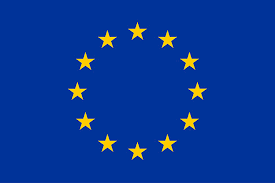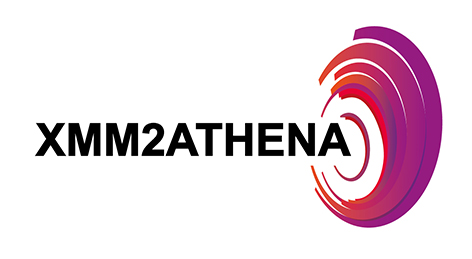

This project has received funding from the European Union's Horizon 2020 research and innovation programme under grant agreement number 101004168, the XMM2ATHENA project.
The XMMSL3 catalogue is the third version of the XMM-Newton slew catalogue. It contains detections drawn from 3120 XMM-Newton pn slew observations, covering an energy interval from 0.2 keV to 12 keV. These observations were made between 2000 August 26 and 2023 August 11. All slew observations are public.
Should you use the catalogue for your research and publish the results, please use the acknowledgement below. The current paper to cite describing the catalogue is (Saxton et al., 2008).
As well as the fits and csv formats of the catalogue distributed below, the following Web-based user interfaces will give access to all or selected associated data products:
The SSC Catalogue Home Page (this page), XSA, and HEASARC allow download of the catalogue file in (binary) FITS. We also provide a Multi Order Coverage (MOC) file of the XMMSL3 footprint, which is available here. The XMMSL3 covers more than 90% of the sky.
| XMMSL3 | XMMSL2 | Increment | |
|---|---|---|---|
| Number of observations | 3120 | 2114 | 1006 |
| Observing interval | 26-AUG-00 -- 11-AUG-23 | 26-AUG-00 -- 31-Dec-14 | 8.5 yr |
| Number of detections | 140735 | 72352 | 68383 |
| Number of 'clean' detections (i.e., VAL_FLAG==CLEAN_SAMPLE) | 46110 | 29393 | 16717 |
| Number of unique sources | 116598 | 63230 | 53368 |
The median flux in the total photon energy band (0.2 - 12 keV) of the catalogue detections is ~ 2.7 × 10-12 erg cm-2 s-1; in the soft energy band (0.2 - 2 keV) the median flux is ~ 1.1 × 10-12, and in the hard band (2 - 12 keV) it is ~ 9.0 × 10-12. erg cm-2 s-1.
Many sources have been identified as possibly spurious and we recommend filtering the catalogue using the VAL_FLAG and/or based on number of counts or on lmaximum likelihood of detection. See below and the users guide for more information.
The XMMSL3 catalogue, released on 2025 February 19th, is available in several formats:
Please read the Watchouts section before using the catalogues.
| xmmsl3_v1.0.fits | FITS binary | 112 MB | MD5: 2439f720f6b4e05e2c9dcba56e5af565 | full binary catalogue |
| xmmsl3_v1.0.csv | CSV | 96 MB | MD5: dd1b9c5b4e5f739638c08899c29f5a05 | full ascii catalogue |
The CSV file has nulls represented by two successive commas, compatible with Postgres and (probably) other DBMS.
The User Guide for the XMMSL3 catalogue contains details of the catalogue production process and content. Here are quick links to
1) It is possible that there are more counts in the soft or the hard band than in the full band. This is because detections are carried out in each band and then combined using a match radius of 30 arcseconds to identify sources detected in more than one band. The match radius is approximately 4 sigma and is reasonable for point sources because of the scarcity of sources (1 detection per square degree on average) at the flux levels probed by the slew survey. Therefore the extraction region maybe placed at slightly different positions, resulting in this incoherance. This also explains why band 8 (full band) may have many more counts than the sum of the soft and the hard band.
2) The catalogue is manually screened to identify possibly spurious detections. We recommend to filter the catalogue on the VAL_FLAG column, keeping only those detections with the CLEAN_SAMPLE qualification to obtain a clean catalogue.
3) The XMMSL3 catalogue has a new major version, as there are twice as many sources as in XMMSL2 and the recommended method for producing a cleaned catalogue has been modified with respect to the previous version, XMMSL2, notably through filtering the catalogue on the VAL_FLAG column, keeping only those detections with the CLEAN_SAMPLE qualification. However, in other respects, it is an incremental version, retaining all detections in XMMSL2 and adding a further 8.5 years of data.
4) Since XMMSL2, there have been a number of revisions made to the source detection tasks and notably to the SAS task emldetect. All detections are tested for their potential spatial extent during the fitting process. The instrumental point-spread function (PSF) is convolved with a β extent model, fitted to the detection, and the extent likelihood is calculated as described by Section 4.4.4 of Watson et al. 2009). A detection is classified as extended if its core radius (of the β-model of the PSF), rc > 6 arcsec and if the extended model improved the likelihood with respect to the point source fit such that it exceeded a threshold of Lext,min = 4. In the XMMSL2 version, when a detection was identified as pointlike, the extent maximum likelihood (EXT_ML_B6, EXT_ML_B7 or EXT_ML_B8) was set to -999. Since version 7.5.2 of emldetect, a negative maximum likelihood is attributed to point-like detections. Lext,min ≥ 4 indicates that a source is probably extended, whilst negative values indicate a clear preference of the point-like over the extended fit. A minimum likelihood difference of four has been chosen to mark a detection as extended. This threshold makes sure that the improvement of the extended over the point-like fit is not only due to statistical fluctuations but from a more precise description of the source profile. Where no detection in a particular band has been made, there is no extension maximum likelihood provided for that band. Therefore, the extension maximum likelihood column is composed of positive and negative values, as well as the value -999 and nulls.
The production of the XMMSL3 catalogue is a collaborative project involving the XMM-Newton SSC Consortium:
The SSC team are grateful to the XMM-Newton SOC for their support in the catalogue production activities.


This project has received funding from the European Union's Horizon 2020 research and innovation programme under grant
agreement number 101004168, the XMM2ATHENA project.
The SSC acknowledges the use of the TOPCAT and STILTS software packages (written by Mark Taylor, University of Bristol) in the production and testing of the XMMSL3 catalogue.